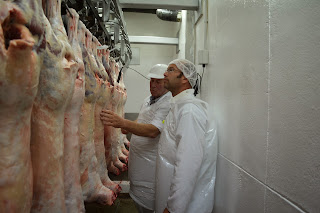My day started with an early meeting in Invercargill at Alliance HQ with Murray Behrent. Murray came to Overbury about 2 1/2 years ago for a farm visit with Randall Parker Foods and after the meeting we exchanged details and I mentioned that one day I would like to visit the operation in New Zealand. Today was that day. We chatted for a while about Hoofprint and what benefits there were to the UK farmer in using system like this. We spoke about lamb sales and marketing around the world and how the global economy is changing the destination of many of New Zealands lamb products and about the rationalisation that has occurred in the meat processing industry since 1990 and how this will continue in the future.
I met up with Hayden again and we headed down to the Lorneville Processing site, locally referred to as 'The Works'. I was very impressed with the overall scale of the operation being conducted in the plant. Hayden and I started off recording some lamb tails from a Sainsbury's docking trial, trying to discover if live weight gain is effected by tail docking or not. Too early for any conclusions but it was interesting to be on the other side of the world and still have a Sainsbury's connection. Last year Hayden did trials on about 15,000 individual animals. The processing plant was incredible, running 4 chains (or lines) of lambs. All of the lambs are stunned and then slaughtered at a rate of 36 lambs/minute which; when all chains are double shifting and woking an extra hour can process 32,000 lambs/day. Lambs are delivered almost 24 hours/day and there is enough pen space in the lairage to hold about 14,000 lambs. Teams of shepherds, each with two dogs unload the animals and keep them moving up through the system. There was a lot going on but it was well organised, calm and relatively stress free which is a good sign.
Before the lambs go off to be cooled they are weighed and put through a VIAScan. This very impressive piece of equipment scans the carcase and works out the percentages of saleable meat in 3 main areas and the farmer is paid accordingly. Measurements are taken from the leg, loin and shoulder. To me this makes perfect sense; with the farmer being rewarded for more saleable better quality meat that yields more to the processor and should be charged at a higher margin to the customer. How far away are these in the UK I wonder?
After the lambs are processed they are moved into various chillers to bring the carcase temperature down to -0.5 degrees. This is done in stages to slightly dry the carcase and slowly bring down the temperature over about 10 hours. The following day the lamb is butchered in one of the 5 cutting rooms, by one of the 60 boners/butchers before being packed, identified and shipped. It takes 6 weeks for the chilled produce to reach the UK where is is further processed before ending up on the shelves of Sainsbury's.
I finished the day back at HQ talking to the sales team who work with UK buyers. We talked about the quality of the product, how it is packaged, processed and delivered and how it really should be a very premium product. New Zealand and UK lamb should not be competing against each other in the market place but working together to manage the supply of lamb between us to ensure the price stays at a sustainable level. On farm and processor, efficiencies need to occur to ensure lamb isn't priced out of the market but with efficient producers and a reasonable price, we should be able to return enough money to invest in the future.





No comments:
Post a Comment